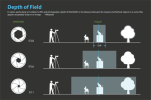Miranda G
Recognized Leader / Outdoor Photography
- State
- Virginia
This post is kind of a companion to my last post on f-stops because your f-stop is key in creating depth of field in your photos. Depth of field is the distance between the nearest and furthest object in a scene that appears acceptably sharp in an image. for example, when photographers want an entire landscape scene in sharp focus, they would shoot with a narrow aperture. This makes f22 a really common setting for landscape photos. On the other side of the f-stop range, a photographer would likely shoot a portrait with an f-stop in the range of f2.8- f5.6. This would create a shallow depth of field, blur the background, and spotlight the subject of the portrait.
This is a good graphic to illustrate the relationship between aperture and depth of field.

The composition of the shot is the same (what you see on your view finder, or view screen is the same), but what appears in focus in the shot can be varied greatly. This variation is what gives the photo its depth.
Obviously there is no rule that states that there are "correct" f-stops for certain types of photos. Again, using our landscape example, f22 is common rather than absolute. Some lenses have apertures that narrow to f40, and for artistic reasons, some photographers may choose to shoot their landscapes at a wide aperture. Using our illustration from above, the photographer could very easily choose to focus on the tree, open the aperture to 5.6, and blur the bunny in the foreground (just imagine the focus box remaining the same size, but moving back to cover the tree).
The aperture on a camera determines the amount of light that enters the lens during the time the shutter is open. So by channeling light through different sized openings, focusing effects can be achieved.
This is a good graphic to illustrate the relationship between aperture and depth of field.

The composition of the shot is the same (what you see on your view finder, or view screen is the same), but what appears in focus in the shot can be varied greatly. This variation is what gives the photo its depth.
Obviously there is no rule that states that there are "correct" f-stops for certain types of photos. Again, using our landscape example, f22 is common rather than absolute. Some lenses have apertures that narrow to f40, and for artistic reasons, some photographers may choose to shoot their landscapes at a wide aperture. Using our illustration from above, the photographer could very easily choose to focus on the tree, open the aperture to 5.6, and blur the bunny in the foreground (just imagine the focus box remaining the same size, but moving back to cover the tree).
The aperture on a camera determines the amount of light that enters the lens during the time the shutter is open. So by channeling light through different sized openings, focusing effects can be achieved.
